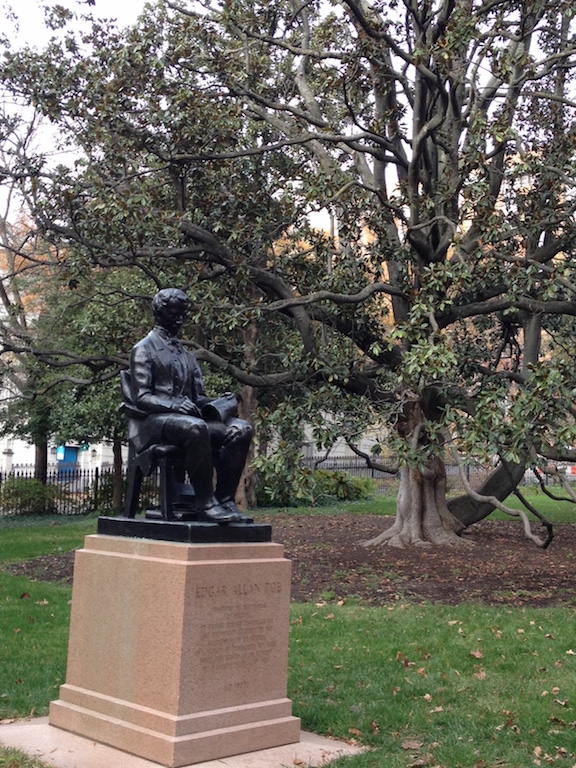ECW Weekender: Poe Museum
![]()
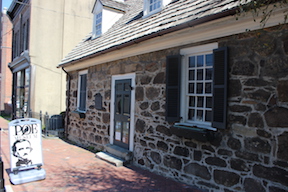
Edgar Allan Poe died in Baltimore under mysterious circumstances in 1849—well before the Civil War. On a recent trip to Richmond, I nonetheless found a few surprising ancillary connections between the writer and the war. The connections all came through, of all things, sculpture, courtesy of a visit to the city’s nifty little Poe Museum.
The Poe Museum is worth a visit for any history- or literature-minded person. Located at 1914-16 E. Main St., in the heart of the city’s historic Shockoe District, “the museum is only blocks away from Poe’s first Richmond home and his first place of employment, the Southern Literary Messenger.” While Poe never lived in the building itself—known as the Old Stone House—it is purportedly the oldest original building in Richmond.
“Richmond’s Poe Museum boasts the world’s finest collection of Edgar Allan Poe’s manuscripts, letters, first editions, memorabilia and personal belongings,” the museum’s website says. “The Poe Museum provides a retreat into early nineteenth century Richmond where Poe lived and worked. The museum features the life and career of Edgar Allan Poe by documenting his accomplishments with pictures, relics, and verse, and focusing on his many years in Richmond.”
Here are a few of the unexpected connections I found during my visit:
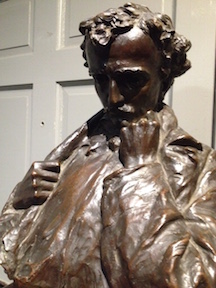
Bust of Poe by George Julian Zolnay
Poe enrolled in the second class to be accepted at the University of Virginia—although he never graduated, having accumulated too much debt to return after his first semester. According to the Poe Museum, UVA commissioned sculptor George Julian Zolnay in 1898 to do a bust of Poe, which unveiled at the library on October 7 of the following year.
“Known as the ‘Sculptor of the Confederacy,’” the Museum goes on to add, “George Julian Zolnay sculpted a number of portraits of Confederate generals, including the statue of Jefferson Davis at Hollywood Cemetery.”
A casting of the bust is on display in the museum.
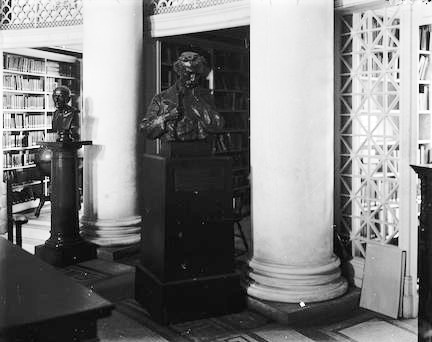
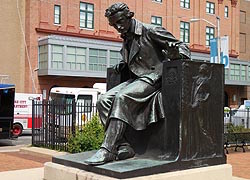
Statue of Poe Moses Ezekiel
If Zolnay was the so-called “Sculptor of the Confederacy,” Moses Ezekiel was not far behind. Ezekiel, a cadet of the Virginia Military Institute who fought and was wounded at the battle of New Market, went on to sculpt a memorial the honored his fallen comrades, Virginia Mourning Her Dead, which stands on the grounds of VMI. Nearby stands a statue of VMI’s most famous faculty member, Stonewall Jackson. Among his other works, Ezekiel sculpted the Confederate monument in Arlington National Cemetery, where is was buried after his death in 1917.
Ezekiel’s last work before his death was a statue of Poe that now stands in Baltimore’s Gordon Plaza at Maryland Ave. & West Mt. Royal Ave. The statue is based on Poe’s poem “The Raven”: Dreaming Dreams No Mortal Ever Dared to Dream Before. Poe died in Baltimore on October 7, 1849, of mysterious causes.
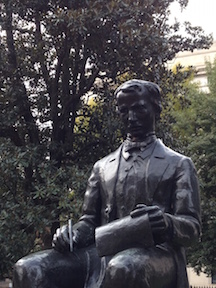
Statue of Poe on the Virginia State Capitol Grounds
The grounds of Virginia’s state capitol building boast an impressive collection of statuary—George Washington, Stonewall Jackson, “Extra Billy” Smith, Dr. Hunter McGuire, among others. Most are clustered on the property’s north side, but situated near the southwest corner, close to the bell tower, sits a statue of Edgar Allan Poe.
The base of the statue reads: “Dedicated to the ‘People of Virginia by retired Richmond physician, Dr. George E. Barksdale in October, 1959.” Sculpted by renowned artist George Ruby, the statue cost $9,500.
A plaster mold of the statue sits in the Poe Museum.
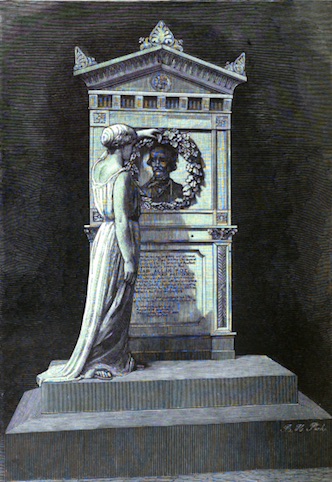
The Actors Memorial to Edgar Allan Poe
In 1885, the “Actors of the City of New York” commissioned a memorial to Poe that they then donated to the Metropolitan Museum of Art. Sculpted by Richard Henry Park, the bronze and marble memorial was dedicated on May 4, 1885.
One of the men who spearheaded the effort, and who spoke at the dedication ceremony, was actor Edwin Booth, brother of the infamous presidential assassin, John Wilkes Booth. “I speak the sentiment of the whole dramatic profession,” Booth said, “when I declare that the American stage is proud and glad to have been the means of paying this tribute to American literature.”
“Poe was not a dramatic poet,” Booth went on to explain. “He wrote but little in the dramatic form; nothing that was ever acted. Yet he was truly a poet—in his prose as well as his verse; and every thoughtful actor must be aware that the success of theatrical arts is considerably due to the influence of poetry upon the public mind. . . .” To prove his point, Booth recited “The Raven” at the dedication.
Although Poe was not a thespian, the Poe Museum pointed out that Poe’s parents were. “Poe’s natural parents, David and Elizabeth Arnold Poe, both actors, were employed by Mr. Placide’s Theatre Company in Boston,” the museum says. “They had been married in Richmond while on tour here in 1806. On December 8, 1811, while again in Richmond, Elizabeth Arnold Poe died. “
The museum kept the memorial on display until 1891, then alternated it in and out of storage, eventually loaning it out to various museums. It 1992, it came to the Poe Museum on long-term loan. “They had to lower it into the museum with a crane,” the museum told me.
